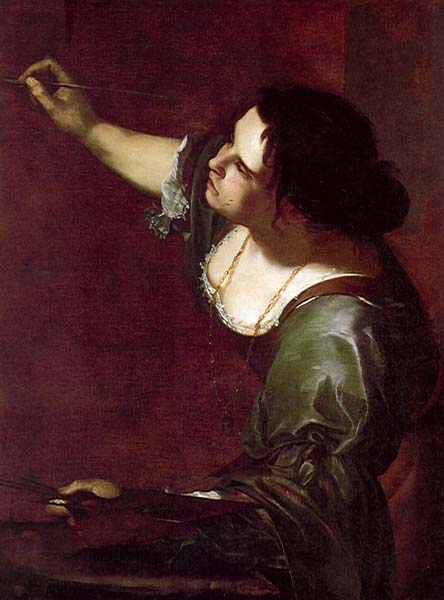
“Self-portrait” by Artemisia Gentileschi, 1630s.
Full Name: Artemisia Gentileschi
Birth Date: July 8, 1593
Death Date (if known): c. 1656
Location: Naples. Italy
Monument Type: Historic/Residence
One of the most famous quotes attributed to painter Artemisia Gentileschi is “My illustrious lordship, I’ll show you what a woman can do” (theartstory.org). Her own life story and art portfolio prove to the world exactly “what a woman can do.”
Artemisia was born in Rome on July 8, 1593 to Orazio Gentileschi and his wife, Prudentia Montone. Artemisia possessed a talent for art early on in her life, with Orazio being a painter himself. Orazio was friends with the famous Baroque painter Caravaggio. The two had even gone to court together for creating slanderous graffiti. Caravaggio inspired Orazio’s work, and he passed this admiration to his daughter. When Artemisia was 12, her mother passed away. The next year, Caravaggio was charged with murder and fled the city.
The earliest painting known to be Artemisia’s is Susanna and the Elders from 1610. People used to believe Orazio had painted it, but the style is more Artemisia’s. The painting depicts the Biblical story of two men harassing Susanna when she was taking a bath. Artemisia paints Susanna as a young woman fighting back against her harassers. This was a stark contrast from the way past male painters depicted the woman, as a passive, sexual being. The next year, her father first worked with the artist Agostino Tassi. Orazio decided to hire Tassi to be a tutor for her daughter. This decision would completely change the course of the family’s lives.
During one private tutoring session, when Artemisia was only 17, Tassi raped her. Soon after the rape, the family made Tassi agree to marry Artemisia, presumably because he had stolen her virtue. When Tassi broke the agreement, Orazio decided to bring him to trial. A father bringing his daughter’s assailant to court was not commonly done at the time. The trial lasted seven months. During it, Artemisia gave plenty of testimony. She faced torture through thumbscrews and a physical examination of her body to prove she wasn’t lying and that she was a virgin before the assault. In the end, the trial found Tassi guilty and exiled him from the city. Unfortunately, Tassi’s exile was never enforced as the Pope supported him and his art.
Shortly after the trial, Orazio arranged a marriage between Artemisia and Pierantonio Stiattesi. Artemisia joined her new husband in his hometown of Florence. The couple had one daughter together in 1618. The marriage was an unhappy one. In Florence, Artemisia had an affair with Francesco Maria di Niccolò Maringhi. Stiattesi was aware of the affair and did nothing to stop it. Evidence suggests that Maringhi may have helped the married couple with their financial struggles, but it was not enough to stop Artemisia from leaving her husband to return home in 1621.
Following her return to Rome, Artemisia was able to work for many different patrons. She had become the first female member of Florence’s Academy of Art and Drawing in 1616. This granted her more financial independence as an artist and thus more opportunities. She worked for the influential Medici family whilst in Florence. In the decade of her return to Rome, she also painted for the Spanish King Philip IV and lived in Venice for a time. She relocated to Naples in 1630. In 1638, she joined her father in England. Orazio had acted as “the court painter since 1626,” and Artemisia helped him work on the ceiling of Queen Henrietta Maria’s home (theartstory.org). When Orazio passed away in 1639, Artemisia stayed in London to finish the painting job. She eventually left England and returned to Italy, likely sometime before the English Civil War broke out in 1642. Not much is known about the end of Artemisia’s life except for the fact that she worked for Don Antonio Ruffo in 1650. Some hypothesize she died of the plague in 1656 during an outbreak in Naples.
After her death, historians erased Artemisia Gentileschi from art history. As her artwork and style was quite like her father’s, many historians attributed her work to Orazio. Roberto Longhi resurrected her name in the early 1900s, with his wife Anna Banti publishing an explicit novel about her life in 1947. It wasn’t until the feminist movement of the 1970s that Artemisia began to be recognized for the power of her work and how it shaped art history.
Indeed, much of Artemisia’s artwork depicted women in a way male artists never had. Unlike other female artists of her time who painted portraits and still life, Artemisia focused on historical and biblical stories. Some of her most famous work besides Susanna includes many versions of Judith Slaying Holofernes (1611, 1613, and 1625), Danae (1612), Lucretia (1623-25), Cleopatra (1633-1635), and Self-Portrait as the Allegory of Painting (1638-39). All these works feature famous women taking control of their lives. Male painters never depicted women in this way. Her art was realistic and brutal, with Judith showing the struggle it takes to behead someone and Cleopatra highlighting the rigor mortis setting in the deceased queen’s body. Her work focuses on the feelings of women, making them their own characters instead of a vessel for men to look at. No doubt her trauma from her rape inspired the rage and anguish seen in many of her paintings. Artemisia Gentileschi’s work is dark and beautiful, showing just what a woman can accomlish.
If you are interested in reading more about Artemisia, I highly recommend Blood Water Paint by Joy McCullough, a novel in verse and prose that depicts Artemisia’s early life and trial and the lives of her two famous subjects: Susanna and Judith.
To see each of the paintings mentioned, check out https://www.theartstory.org/artist/gentileschi-artemisia/
Sources:
https://www.britannica.com/biography/Artemisia-Gentileschi
https://www.biography.com/artist/artemisia-gentileschi
https://www.theartstory.org/artist/gentileschi-artemisia/
